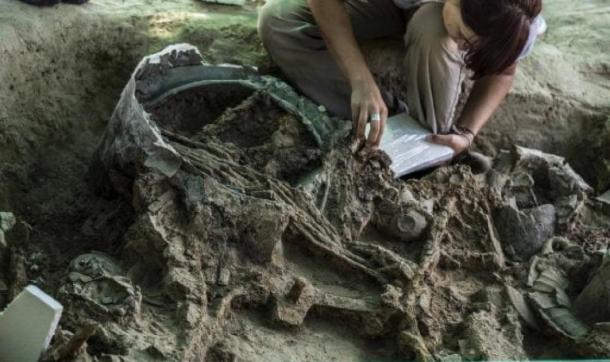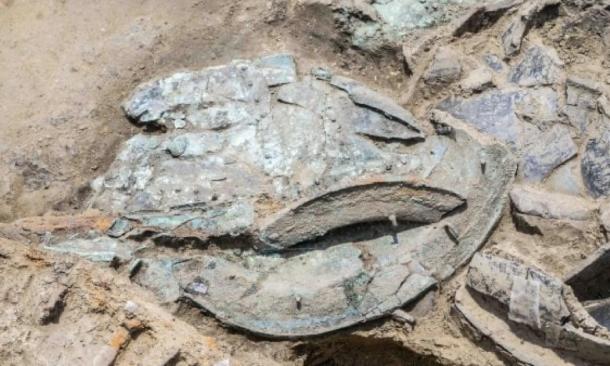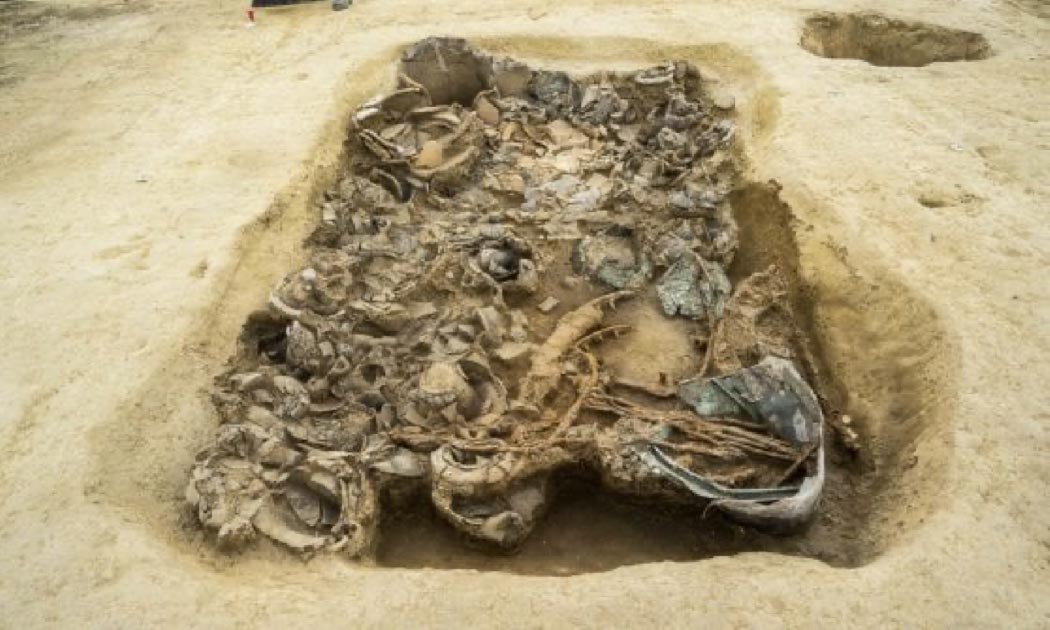In Corinaldo, in the central Italian province of Ancona, the tomb of a Picenian warrior prince from the 7th century BC was discovered in July of 2018 with an amazing haul of artifacts.
According to the research paper at cambridge.org, the grave was found when a new sports arena in the Nevola River Valley was at the planning stage. Soprintendenza Archeologia Marche and the Municipality of Corinaldo allowed ArcheoNevola, a project of the University of Bologna, to perform a non- invasive aerial survey, geophysical work and then conduct an archaeological excavation before construction started.

After finding the grave, the team used landscape-mapping technologies and non-destructive field techniques to reconstruct the Nevola River Valley.
The grave covered an area of about a half of an acre of land with three large ring ditches along with later Roman burials and may have been surrounded by a moat and covered by a mound.
The center of the ring was excavated and an iron-wheeled war chariot, a bronze helmet, bronze vessels, a large cache of weapons and iron skewers along with other treasures were recovered.
The chariot is remarkable because iron was not readily available at the time. An olla, a large ceramic jar imported from ancient Daunia (now northern Apulia in the south of Italy) was also found indicating the grave owner was a wealthy, powerful man among his peers.

It also speaks of the trade that existed with the Apulian region in the boot heel of Italy on the coast of the Adriatic Sea.
Unfortunately, the grave owner is no longer present with some researchers believing that he was buried so close to the surface that his remains have been scattered over the field over hundreds of years of plowing. Some fragments of bone found in the pit will be DNA tested to find out if the deceased was male or female.
Archeologynewsnetwork.com tells us that Federica Boschi, professor of geophysics applied to archaeology at the University of Bologna and director of the excavation remarked, “It is one of the largest tombs ever found after that of the Picenian queen of Sirolo and it is almost on the northern border of the area inhabited by the Piceni, before the Romans, which included the Marche and part of Abruzzo.”
The varied types of relics found indicates the associations of the wealthy and powerful along the coat of Italy and is comparable to the Piceni Orientalizing necropolises from southern Marche.
Britannica.com tells us the Etruscans, pre Roman Italians who lived about 700BC, had contact with the Greeks who traded as far away as Egypt and the Middle East.

The Piceni people bought Asian style art and pottery from them and took it to the Mediterranean area. Everyone wanted the new style and pottery from Italy began to look Asian.
The Etruscan Orientalizing period ran from the 7th century BC until the 1st century BC when the Romans absorbed the Etruscan culture and historians believe the Piceni Orientalizing period occurred about the same time.
The Sirolo Queen Grave was found at Pini place and was filled with grave goods comparable to the ones found in the tomb of the Picenian warrior.
The trove was discovered in 1989 and consisted of two chariots; an amber and ivory kline, a couch used for dining; oinochoe, a wine jug; a bronze tripod; iron spears and typical funerary dress of sandals, pendants and assorted fibulas.
Many of the relics from this burial are on display at the Antiquarium Numana State Museum in the Province of Ancona which was once populated by the Piceni people.
Not much is known of the Piceni culture. According to britannica.com, the Piceni were warriors who left very little cultural remains but were able to sustain a lasting trade with the Greeks.
Another Article From Us: Hundreds Of Pure Gold Roman Coins Found in Italy
The ancient people dressed in wool with the men frequently wearing armor and carrying weapons by their side. Women wore torcs, bracelets and pendants made from bronze or iron.
